She was eventually unveiled the long-awaited Ferrari SF16-H, the car with which Scuderia from Maranello will try to bring back the title in Italian is missing, now, from different vintages.
At the technical level, as we have already spoken to you several weeks ago, the Ferrari SF16-H, first project born from the minds of the trio Allison – stay – Binotto, will present many innovations and represents a real breaking point with the cars that preceded it.
We analyze, in detail, the various aerial vehicle:
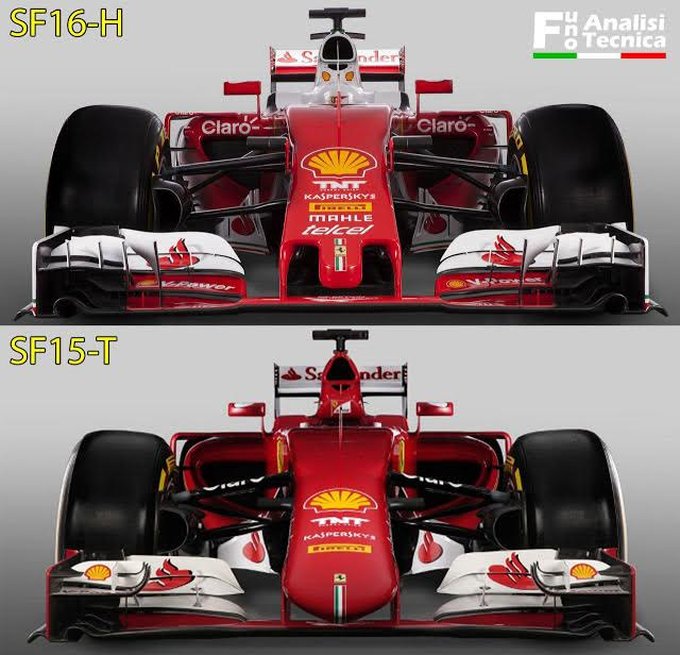
a muzzle VERY SIMILAR tO THAT USED bY REDBULL iN 2015
to try to increase downforce, thanks to greater air flow to it under the muzzle, was abandoned the long version mounted on SF15- T opting for a much shorter version, very similar to the muzzle Red Bull used by the GP of Spain in 2015 (as well as the piers). It will be interesting to see if the muzzle version shown today will undergo further work during the winter tests or during the first few races of the season.
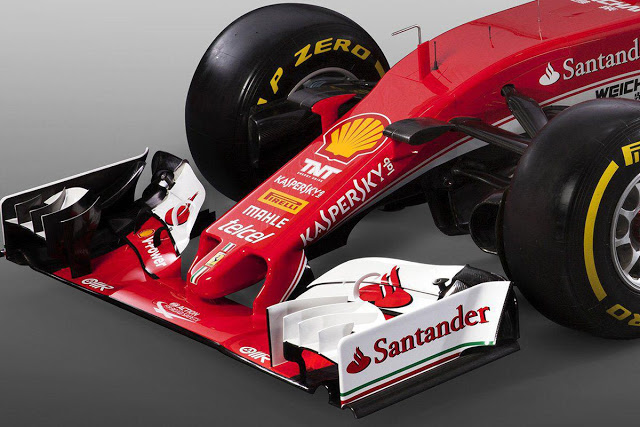
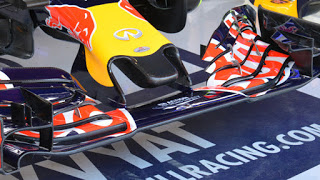
The ALA fRONT AND ‘THAT INTRODUCED IN US GP in 2015
* The front wing SF16-H on the dummy is a wing definitely temporary, since it is the same one used on the SF15-T from Austin GP. Note the presence of a flow diverter anchored on the main profile, the presence of an upper flap in two elements with two other small flow diverters to move the air flow in the outer zone of the tire. On the mainplane is present a very wide blowing, which runs the long transverse axis of the vehicle and the part of the now famous tunnel entrance (black colored area) has an angular shape and slightly rounded. As for the hubs blowers, albeit capped mannequin shown to us in this day, they seem to be confirmed on the car in 2016.
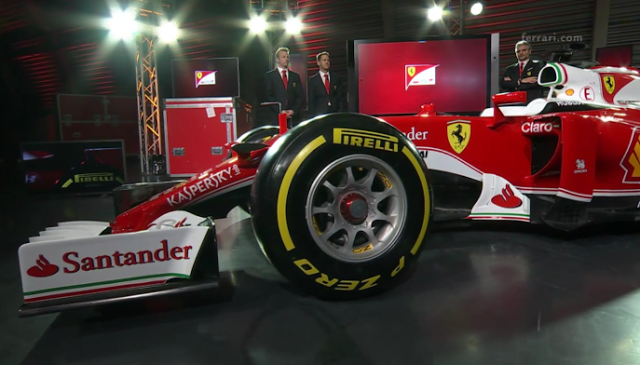
IS FINALLY BACK tO fRONT sUSPENSION PUSH ROD
After 4 seasons of use of the front suspension pull rod, Ferrari has once again use the diagram strut (push rod). The front suspension has been trying to work to the best positioning of the elements that compose it to try to create the least possible aerodynamic disturbance. Apparently, it does not seem to have been maintained in the pattern pitch on the lower triangle of the suspension.
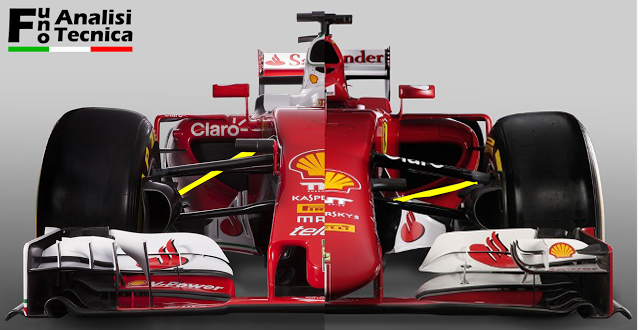
A VANITY PANEL HIDING A POSSIBLE S-DUCT
Looking good the sample images shown from Ferrari you can see that at the top of the new Ferrari snout is a vanity panel was applied; This may hide the fact that the Italian team, since the test program next week, uses its own version of S-Duct. This technical detail, to finish the speech, there has never been confirmed during the pre season. But the Barcelona test only shortly!
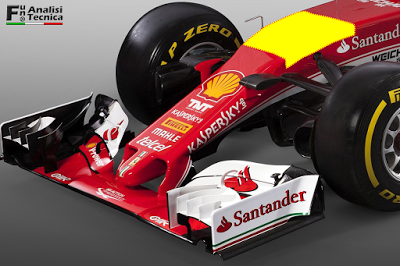
tHE SF16-H HA OF nEW FLOW SWITCHES
Even in the central area, the Ferrari has introduced numerous innovations. The flow diverters now have a new form, maintaining the “bridge” scheme although now the inner part, which was composed of a flap useful to generate vortices to energize the flow sent to the rear, has been eliminated. Even the outer bridge portion has undergone changes in size and shape. The connected white deflector (which now also has the Italian flag) to the vehicle floor instead has remained the same as that fitted to the Ferrari SF15-T. With regard to the air inlets, it can be said that have remained as surface, very similar to those present on the SF15-T even if the shape has been slightly changed.
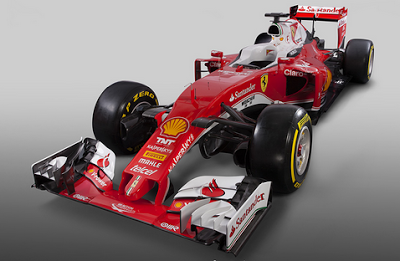
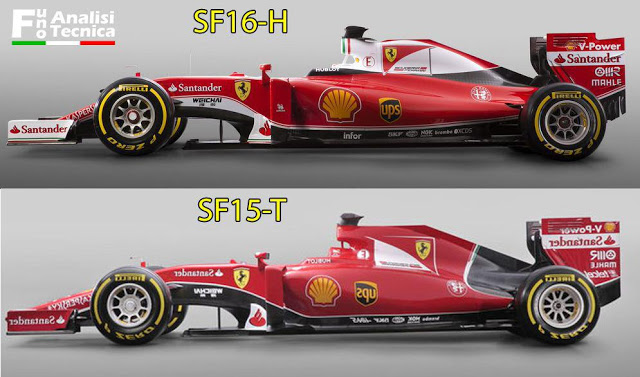
a GREAT wORK oN VEHICLE BODY AND BACK
the major work carried out on the internal arrangement of the power unit components has allowed the Maranello’s engineers to make the sides that are going to tighten ahead of what was happening the SF15-T. Thanks to a very tapering thrust (see last photo), the amount of air coming in this season in the top of the speaker will be much higher compared to 2015.
As for the airscope, useful to bring air to the engine, you can see the first photos of the item as it changed shape while the size has remained much the same.
the bonnet has a definitely less marked fin and a final section very special, because as you can guess, Ferrari uses this part of the body for purely aerodynamic. Thanks to through-air ducting through the bonnet, it goes to feed the entire upper part of the diffuser, trying to maximize the aerodynamic load generation by this component.
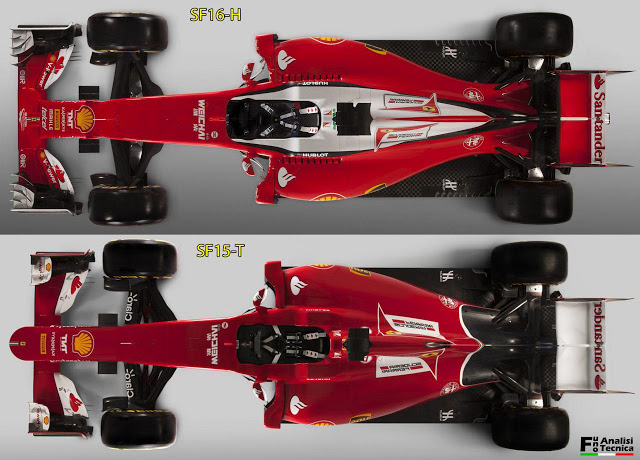
were retained on the bottom, in the vicinity of the rear wheels, the 9 blowholes introduced in Singapore GP 2015, which are exploited as real flow dividers so as to allow a greater influx of air in the upper zone of the diffuser and thus increase the generated load. In practice, it goes to increase the vorticity, to try to seal the most possible the vehicle floor and the area between tire and diffuser. With such slits will be to obtain a pressure difference between the top and bottom of the higher diffuser, thereby increasing the generated aerodynamic load.
confirmed monopilone solution to the rear for the rear wing support with monkey seat directly hooked to the supporting pylon. This pylon, as you can see below (already perhaps by testing) is going to enter into the drain, taking up a little the solution used by the Red Bull in 2015. In doing so Ferrari hopes to get from the inner pylon to the drain, a small aerodynamic advantage, that is to “straighten” a very turbulent flow in the turbine outlet. As you can see from the picture below, in addition to the main drain was used in addition as required by Regulation 2016, two small exhaust wastegate placed at the sides of the main one. solution very similar to the one taken by Mercedes , even if the two drains will be in a position, to our knowledge, outermost on the Italian Power Unit.
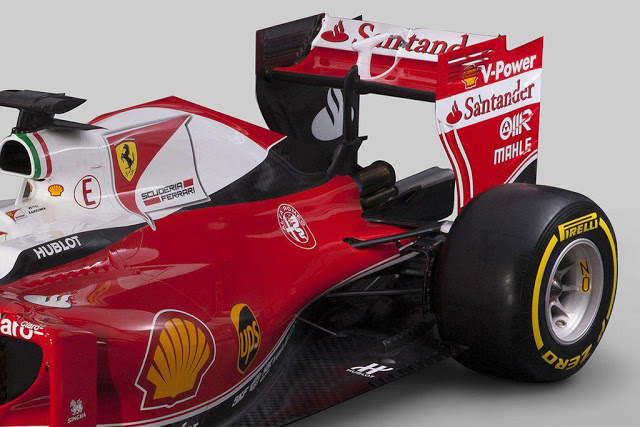
Finally, Ferrari there didnt see much, but not all, of the techniques already so expect change from the mannequin seen today, in the first test that will start next Monday at the Barcelona circuit. Not counting the many changes present under the hood! It ‘just the beginning dear readers.
Christian Sponton and Piergiuseppe Donadoni
19th February, 2016
Tags: technical analysis Ferrari SF16-h, ferrari, ferrari-h SF16, SF16 new ferrari-h, technical innovations Ferrari SF16-h
No comments:
Post a Comment